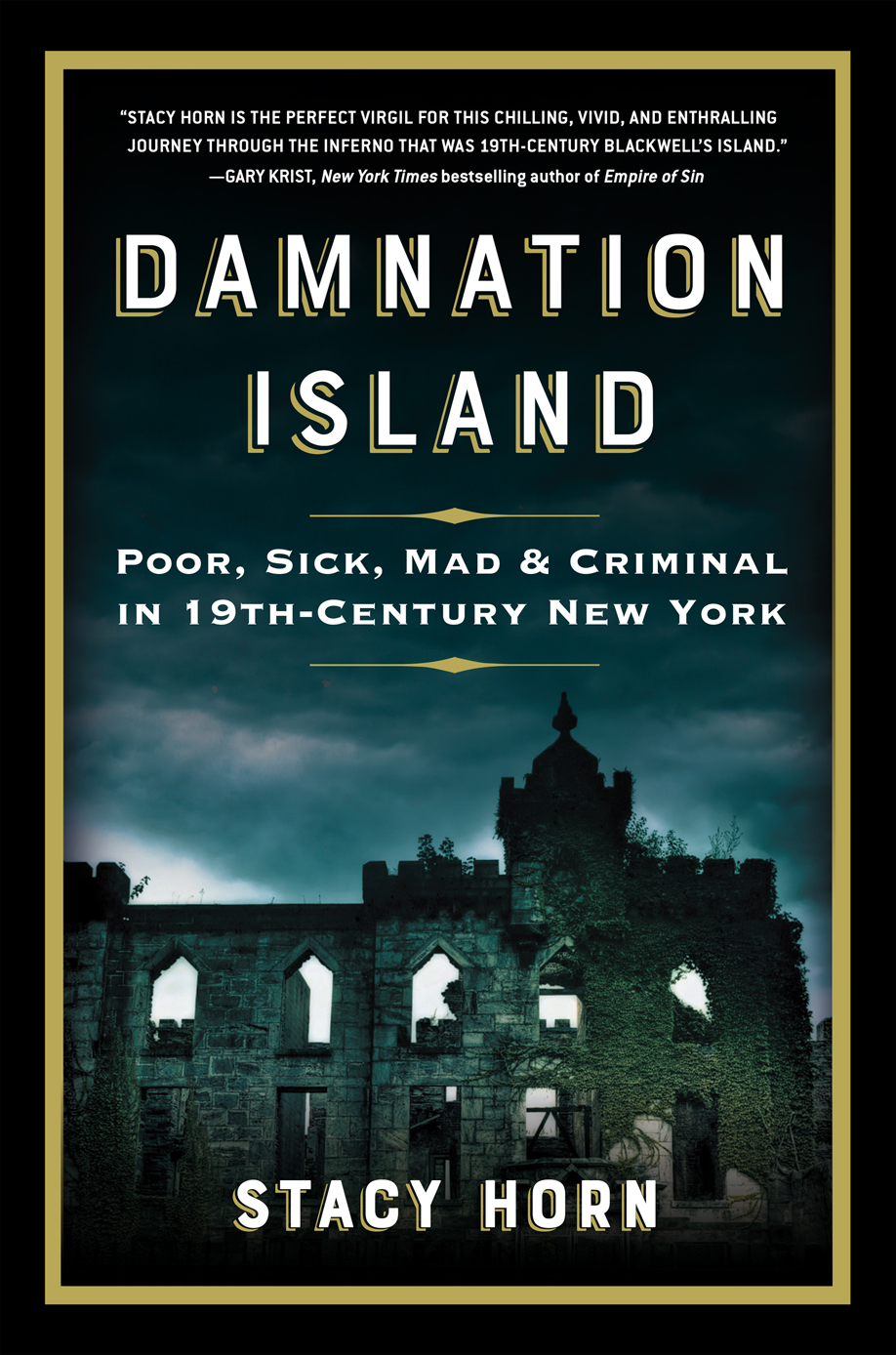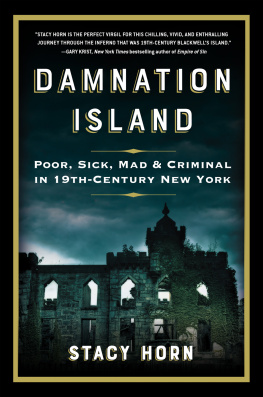Stacy Horn - Damnation Island
Here you can read online Stacy Horn - Damnation Island full text of the book (entire story) in english for free. Download pdf and epub, get meaning, cover and reviews about this ebook. publisher: Algonquin Books, genre: Non-fiction. Description of the work, (preface) as well as reviews are available. Best literature library LitArk.com created for fans of good reading and offers a wide selection of genres:
Romance novel
Science fiction
Adventure
Detective
Science
History
Home and family
Prose
Art
Politics
Computer
Non-fiction
Religion
Business
Children
Humor
Choose a favorite category and find really read worthwhile books. Enjoy immersion in the world of imagination, feel the emotions of the characters or learn something new for yourself, make an fascinating discovery.

- Book:Damnation Island
- Author:
- Publisher:Algonquin Books
- Genre:
- Rating:4 / 5
- Favourites:Add to favourites
- Your mark:
- 80
- 1
- 2
- 3
- 4
- 5
Damnation Island: summary, description and annotation
We offer to read an annotation, description, summary or preface (depends on what the author of the book "Damnation Island" wrote himself). If you haven't found the necessary information about the book — write in the comments, we will try to find it.
Stacy Horn: author's other books
Who wrote Damnation Island? Find out the surname, the name of the author of the book and a list of all author's works by series.
Damnation Island — read online for free the complete book (whole text) full work
Below is the text of the book, divided by pages. System saving the place of the last page read, allows you to conveniently read the book "Damnation Island" online for free, without having to search again every time where you left off. Put a bookmark, and you can go to the page where you finished reading at any time.
Font size:
Interval:
Bookmark:

Damnation
Island

POOR, SICK, MAD & CRIMINAL
IN 19TH-CENTURY NEW YORK

STACY HORN

ALGONQUIN BOOKS OF CHAPEL HILL 2018
ALSO BY STACY HORN
Imperfect Harmony: Finding Happiness Singing with Others
Unbelievable: Investigations into Ghosts, Poltergeists, Telepathy, and Other Unseen Phenomena from the Duke Parapsychology Laboratory
The Restless Sleep: Inside New York Citys Cold Case Squad
Waiting for My Cats to Die: A Morbid Memoir
Cyberville: Clicks, Culture and the Creation of an Online Town
To all those who have ever
been judged unworthy.
Contents
PROLOGUE
Workers for the Edison Electric Illuminating Company had spent more than a year ripping up the streets of lower Manhattan. The miles of cable that now lay unseen somewhere beneath their feet were making some people nervous. Two weeks before the new lamps were to be lit for the rst time, the New York Times ran a story about horses that had been shocked on one of the blocks within the electried grid. Absurd, Edison Electric responded. The conductors were buried two feet underneath the street, and encased in an iron pipe a quarter of an inch in diameter. Even if the pipe broke, the current would scatter through the earth rendering it utterly harmless. Anything could have spooked those horses.
The rst test of electric light distributed via a central power station in New York City would go ahead as planned, on September 4, 1882.
On Monday afternoon at 3 p.m. the switch was thrown. Four-hundred lamps for eighty-ve initial customers came to life, powered by six 27-ton, exuberantly named dynamos (today called generators). One of those customers was the New York Times. A grateful reporter wrote about working that night by light as bright as day... without a particle of icker, and with scarcely any heat to make the head ache. The new lights also lit up their rooms without the nauseating smell of the gaslights that electricity replaced. That December, a vice president of Edisons company wrapped his familys Christmas tree with eighty red, white, and blue light bulbs, and placed it on a revolving pine box. As the tree turned, the tiny lights went off and on, creating a continuous twinkling of dancing colors for his lucky children, and neighbors who strolled by for a peek inside. Everything, all the lights and the fantastic tree itself with its starry fruit, which kept going by the slight electric current brought from the main ofce on a lmy wire, so delighted a Detroit Post and Tribune reporter who was in New York that he could hardly imagine anything prettier.
The city itself became a fantastic display as Edison and his competitors raced to illuminate all the streets. An editor visiting from London described the sight: The effect of the light in the squares of the Empire City can scarcely be described, so weird and so beautiful is it. What some had feared, he saw as magical. Enormous standards, rising far above the trees, are erected in the centre of each square. From these standards the light is thrown down upon the trees in such a way as to give them a fairy-like aspect... the shadows they cast on the pavement below appear very like living objects.
As time went on, more and more outdoor lamps lit up Manhattan, and by 1884 the bright, white moonlight effect could be seen for miles around, a glow that illuminated the city every evening, like a brilliant cloud.
That same year, the City of New York sent tens of thousands of people to Blackwells Island, a narrow, two-mile-long strip in the East River where theyd built a Lunatic Asylum, an Almshouse for the Poor, two penal institutions, and over half a dozen hospitals for different classes of inmates. For those who caught an evening glimpse the night before being ferried across, it might have felt like they were being carried away from a radiant future that they would never inhabit. Instead, they were transported into the dank, nauseating, gas- and kerosene-lit past of Blackwells Island, where they would be swallowed upthe enchanted, incandescent island of Manhattan in fact lost to many of them forever.
Those sent to the prisons, or even the Lunatic Asylum, could at least entertain a hope of one day getting out, assuming they werent committed during a cholera outbreak which could kill them, or housed with a murderous inmate, who might do the same. But a great number of them, especially the unfortunates sent to the Almshouse, were generally too old or their bodies too broken to hope they would ever return to the bright city again. Their prospect for recovery had been judged so unlikely that someone had written Future Doubtful, or worse, Permanently Dependent, on their application for relief. For them, the Almshouse would be their last stop before death, dissection, and a burial in the potters eld.
Initial planners for Blackwells would have been mortied at how wretched and deadly conditions there had become. When the island was bought by the city for $32,500 in 1828 (they would end up paying $20,000 more to settle a lawsuit), their goal was to relieve the crowded conditions at Manhattans Bellevue, which in addition to being a hospital was also the location of the citys Penitentiary, the Lunatic Asylum, an Almshouse for the poor, and the Workhouse, a prison for people convicted of minor crimes. As the city had grown, so had the number of the poor, the lunatic, and the criminal, all of whom had to be treated somewhere when they got sick.
Why have we not establishments worthy of our city? an expert they would consult later asked, summing up just what legislators had been thinking at the time. Their idea was to move the sick, mad, and punishable away from the general population and into the more humane, stress-free, and healthful environment of this lush, pastoral island, thick with fruit trees, where they could be classied according to their afiction or crime, installed in their respective institutions, controlled, and nally reformed. The inmates would get all the benets of modern science and a chance at a future, and except for the employees of the institutions, no one need be troubled about their existence ever again. The island also conveniently had stone quarries that could serve the dual purpose of providing the city with the materials for the buildings, and the prisoners and the poor with a useful occupation: breaking, blasting, and preparing rocks.
Everyone was in high spirits on that promising day when the cornerstone of the rst institution was laid. John Stanford, the citys prison chaplain, thanked God for teaching America how to season justice with mercy, and a condent Mayor William Paulding Jr. told the assembled crowd of guests that their state-of-the-art establishment would prove an honor to our city. What could be more restorative for the unfortunates of the burgeoning metropolis, it was reasoned, than the peaceful, verdant island in the East River, tucked safely away from vice and crime between two swiftly running channels, surrounded by picturesque sailboats, ferries, and steamers, and the wooded reaches of upper Manhattan and Queens behind them?
Blackwells Island was an extension of everything the New World offered, poured into 147 acres. Even the marginalized and maligned would have it better here and nothing less than the latest scientic methods would be employed to give them a chance to turn their lives around. On the Island everyone would be tended to in brand-new institutions with pioneering facilities. Whether they were consigned there for humane punishment, healing or relief, this was America, and here in America we were going to do everything better. The mayor and his fellow dignitaries crossed the river back to Manhattan satised that theyd put the largest city of the expanding young country rmly on the path of enlightened reform.
Font size:
Interval:
Bookmark:
Similar books «Damnation Island»
Look at similar books to Damnation Island. We have selected literature similar in name and meaning in the hope of providing readers with more options to find new, interesting, not yet read works.
Discussion, reviews of the book Damnation Island and just readers' own opinions. Leave your comments, write what you think about the work, its meaning or the main characters. Specify what exactly you liked and what you didn't like, and why you think so.










